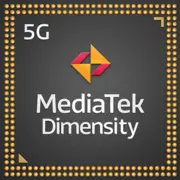MediaTek Dimensity 1300

MediaTek Dimensity 1300: Balancing Power and Affordability in the 5G Era
April 2025
Introduction
Modern smartphones demand not only high performance from processors but also energy efficiency, support for advanced technologies, and affordability. The MediaTek Dimensity 1300, introduced in 2023, remains a relevant solution for mid-range devices even in 2025. In this article, we will explore what makes this system-on-chip (SoC) noteworthy, who it is suitable for, and how it compares to competitors.
1. Architecture and Process Technology: The Foundation of Performance
6nm Process Technology: Efficiency and Compactness
The Dimensity 1300 is built on TSMC's 6nm process technology, ensuring a balance between power consumption and performance. This allows for more transistors to be placed on the chip without overheating, which is critical for mobile devices.
CPU: 8-Core Hybrid Architecture
- 1x Cortex-A78 (up to 3.0 GHz): The main core for heavy tasks: gaming, video rendering.
- 3x Cortex-A78 (up to 2.6 GHz): Assistants for multithreaded operations.
- 4x Cortex-A55 (up to 2.0 GHz): Energy-efficient cores for background processes.
This configuration (1+3+4) ensures smooth multitasking and battery savings.
GPU: Mali-G77 MP9 – Graphics for Gaming and Creativity
The Mali-G77 MP9 graphics processor with 9 cores supports the Vulkan 1.1 and OpenGL ES 3.2 APIs, allowing modern games to run on medium to high settings. The HyperEngine 5.0 technology optimizes the GPU load, reducing latency and stabilizing FPS.
2. Real-World Performance
Gaming: Smoothness without Compromise
- Genshin Impact: 45–55 FPS on medium settings (1080p).
- Call of Duty: Mobile: 60 FPS in Ultra HD mode.
- PUBG New State: Stable 60 FPS at high settings.
For gamers, support for 120 Hz displays is important and many smartphones based on Dimensity 1300 (e.g., Realme GT Neo 4) offer this feature. However, in intense scenes, FPS may drop to 40, where dynamic resolution scaling helps.
Multimedia: 4K and HDR
The chip decodes video in 4K@60fps and supports HDR10+. Smartphones with this processor are often equipped with OLED screens, making content viewing vibrant and detailed.
AI Applications: Accelerating Neural Networks
The built-in APU 3.0 (AI Processing Unit) accelerates tasks such as photo processing (night mode, scene recognition), voice assistants, and AR applications. For instance, shooting in low light takes 30% less time thanks to AI algorithms.
Power Consumption and Heating
Thanks to the 6nm process and ARM optimization, the chip demonstrates moderate heating even under load. In PCMark tests (working with office applications), smartphones based on Dimensity 1300 show up to 12 hours of autonomy with a 5000 mAh battery capacity. In gaming, consumption is higher – about 6–7 hours.
3. Built-in Modules: The Connectivity of the Future
5G Modem: Speeds up to 4.7 Gbps
The integrated modem supports both SA/NSA 5G networks, providing download speeds of up to 2.3 Gbps (Sub-6 GHz). This allows for downloading a 4K movie in 30–40 seconds.
Wi-Fi 6 and Bluetooth 5.3
- Wi-Fi 6 (802.11ax): Speeds up to 1.2 Gbps, providing stable connections in crowded places.
- Bluetooth 5.3: Low power consumption for wireless earbuds and synchronization with smartwatches.
Navigation: GPS, GLONASS, Galileo, and BeiDou
Positioning accuracy is up to 1 meter, which is important for mapping services and running applications.
4. Comparison with Competitors
Snapdragon 7 Gen 2:
- Better GPU (Adreno 710) – higher FPS in games.
- Higher device prices ($450–600 vs. $300–500 for Dimensity 1300).
Exynos 1380:
- Comparable CPU performance, but weaker GPU (Mali-G68 MP5).
- Less support for 5G frequency bands.
Dimensity 1200 (previous generation):
- Dimensity 1300 has 15% higher energy efficiency and an improved AI block.
Conclusion: The MediaTek Dimensity 1300 is optimal for those seeking a balance between price and 5G capabilities. While it lags behind the Snapdragon 7 Gen 2 in gaming, it excels in cost.
5. Use Cases
Gaming:
Suitable for mobile gaming enthusiasts who are not willing to pay for flagship devices. Models with cooling systems (e.g., Poco X5 Pro) are recommended.
Everyday Tasks:
Smooth operation of social media, streaming, and multitasking (simultaneous launching of 10–15 applications).
Photography and Video:
Supports cameras up to 200 MP and 4K@60fps recording. AI enhancements for photos and portrait mode with precise background separation.
6. Pros and Cons
Pros:
- Affordable device prices ($300–500).
- Support for 5G and Wi-Fi 6.
- Good battery life.
Cons:
- Mali-G77 MP9 is weaker than competitors' GPUs in its class.
- No support for screens with refresh rates above 144 Hz.
7. Practical Tips for Choosing a Smartphone
- Cooling: Look for models with vapor chambers – for example, Xiaomi Redmi Note 12 Pro+.
- Display: AMOLED with a 120 Hz refresh rate for comfortable gaming.
- Battery: At least 5000 mAh for long usage.
Popular Devices of 2025:
- Realme GT Neo 4 ($350): 120 Hz AMOLED, 65W charging.
- Vivo V27 ($400): 50 MP camera with optical stabilization.
8. Final Conclusion: Who Is the Dimensity 1300 For?
This processor is an ideal choice for:
1. Budget Gamers looking for lag-free gaming without paying flagship prices.
2. Students and Active Users who value battery life and 5G speed.
3. Content Creators shooting 4K videos and editing on their smartphones.
Main Advantages: Affordability, energy efficiency, and readiness for future technologies. Even two years after its release, the Dimensity 1300 remains relevant in a world where 5G and high loads have become the norm.
If you are looking for a smartphone "for all occasions" without paying a premium for brand names, devices based on the MediaTek Dimensity 1300 should be considered first.
Basic
3x 2.6 GHz – Cortex-A78
4x 2 GHz – Cortex-A55
GPU Specifications
Connectivity
Memory Specifications
Miscellaneous
Benchmarks
Phones with Dimensity 1300




Comparison of Devices with Dimensity 1300
Compared to Other SoC
Share in social media
Or Link To Us
<a href="https://cputronic.com/en/soc/mediatek-dimensity-1300" target="_blank">MediaTek Dimensity 1300</a>